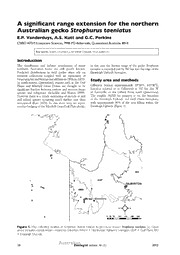
A significant range extension for the northern Australian geckoStrophurus taeniatus PDF
Preview A significant range extension for the northern Australian geckoStrophurus taeniatus
A significant range extension for the northern Australian gecko Strophurus taeniatus E.P. Vanderduys, A.S. Kutt and G.C. Perkins CSIRO ATSIP, Ecosystem Sciences, PMB PO Aitkenvale, Queensland, Australia 4814 Key words: Strophurus taeniatus, Einasleigh Uplands, range extension Introduction The distribution and habitat associations of many in this case the known range of the gecko Strophurus northern Australian fauna are still poorly known. taeniatus is extended east by 360 km into the edge of the Predicted distributions in field guides often rely on Einasleigh Uplands bioregion. museum collections coupled with an assessment of biogeographic and bioregional affiliations (Wilson 2005). Study area and methods In north-eastern Queensland, regions such as the Gulf Plains and Mitchell Grass Downs are thought to be Gilberton Station (approximately 19º16’S; 143º40’E, significant barriers between eastern and western fauna hereafter referred to as Gilberton) is 330 km due W species and subspecies (Schodde and Mason 1999). of Townsville on the Gilbert River, north Queensland. However there is a steady smattering of records of arid The roughly 34,000 ha property is on the boundary and inland species occurring much further east than of the Einasleigh Uplands and Gulf Plains bioregions, anticipated (Kutt 2003). In this short note we report with approximately 96% of the area falling within the another bridging of this Mitchell Grass/Gulf Plain divide; Einasleigh Uplands (Figure 1). Figure 1. Map indicating location of Gilberton Station relative to previously known Strophurus taeniatus (x). Open arrow indicates closest known record to Gilberton. NWH = Northwest Highlands bioregion; GUP = Gulf Plains; EIU = Einasleigh Uplands. Australian 20 Zoologist volume 36 (1) 2012 Range extension for the northern Australian gecko In October 2008, 32 standardised fauna monitoring sites identical to QMJ88151. Habitat at this location is open were established on Gilberton as part of ongoing surveys Eucalyptus crebra, E. normantonensis, E. persistens and Acacia across the Einasleigh Uplands and Gulf Plains. Each site shirleyi woodland on a lateritic escarpment with spinifex utilised an array of survey techniques including pitfall, (Triodia sp.) dominated ground cover. funnel, Elliott and cage traps as well as active search The records presented here further highlight a number techniques including spotlighting at night (see Kutt and of important but oft-repeated facets of survey and Woinarski 2007 for a description). Basic habitat data inventory monitoring; basic distribution information including soil description, dominant plant species, basal for some Queensland vertebrate species is still lacking; area and other floristic measures were also taken following single surveys are often a snapshot of what species might methods outlined in Eyre et al. (2006). be present in an area and a thorough inventory of any To determine known range of Strophurus taeniatus, area requires repeated surveys over multiple years; and relevant texts (Cogger 2000, Wilson and Swan 2008; our current understanding of biogeographic affinity of Wilson 2005) were consulted and database searches of all species and regions is possibly not as well-formed as we relevant herpetology collections from Australian museums might like to think. were conducted. In addition, specimen records were downloaded from the OzCam (http://www.ozcam.gov.au/ cgi-bin/emu-dataportal.cgi) website on 10 November 2009 (searches under Diplodactylus taeniatus and Strophurus taeniatus). Locations of the nearest previous specimens of S. taeniatus are presented in Fig. 1. Results and discussion A single S. taeniatus was collected from a pitfall trap on 17th October 2008 from open Eucalyptus crebra, E. persistens, Corymbia pocillum, Melaleuca citrolens and Acacia shirleyi woodland on stony lateritic soil with spinifex (Triodia sp.) dominated ground cover. The location was 19º14’S, 143º39’E (GDA94). This specimen is lodged at the Queensland Museum (QMJ88151; Fig. 2). A second individual was seen, but not collected, on the night of 17th October 2008 Figure 2. Strophurus taeniatus (QMJ88151) collected from at 19º13’S, 143º39’E (GDA94). This individual looked Gilberton, N Qld. Acknowledgements This survey was carried out under Queensland Department WITK04645707 and CSIRO Animal Ethics Committee of Environment and Heritage Scientific Purposes Permit approval 2AR06-22. References Cogger, H. G. 2000. Reptiles and Amphibians of Australia. Reed OZCAM (Online Zoological Collections of Australian Books Australia. Museums) 2009 http://www.ozcam.gov.au/ Eyre T. J., Kelly A. L. & Neldner V. J. 2006. BioCondition; Schodde R. & Mason I. J. 1999. The Directory of Australian a terrestrial vegetation condition assessment tool for biodiversity in Birds: Passerines. A taxonomic and zoogeographic atlas of the Queensland. Field Assessment Manual. Version 1.5. Environmental biodiversity of birds of Australia and its territories. CSIRO Protection Agency, Brisbane. Publishing, Collingwood. Kutt A. S. 2003. The Spinifexbird Eremiornis carteri in the Wilson, S. & Swan, G. 2008. A Complete Guide to Reptiles of Desert Uplands Bioregion, north-central Queensland: a Australia. New Holland Publishers, Sydney. geographic isolate or a nomadic metapopulation? Australian Wilson, S. 2005. A Field Guide to Reptiles of Queensland. Reed Zoologist 32: 246-251. New Holland, Sydney. Kutt A. S. & Woinarski J. C. Z. 2007. The effects of grazing and fire on vegetation and the vertebrate assemblage in a tropical savanna woodland in north-eastern Australia. Journal of Tropical Ecology 23: 95-106. Australian 2012 Zoologist volume 36 (1) 21
